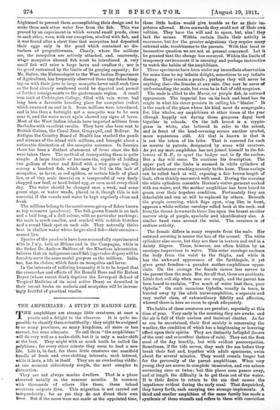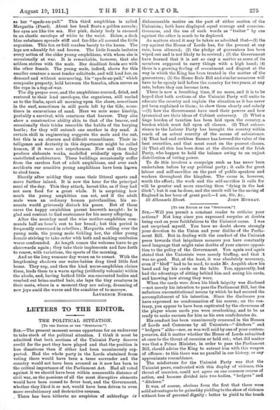THE AMPHIBIANS : A STUDY IN MARINE LIFE.
THE amphibians are strange little creatures, at once a puzzle and a delight to the observer. It is quite im- possible to classify them scientifically: they might be assigned to so many provinces, so many kingdoms, all more or less correct, but none adequate. To call them "the amphibians" will do very well as a make-shift, but it is only a make-shift at the best. They might with as much truth be called the polybians ; for every other minute they seem to lead a new life. Life is, in fact, for these little creatures one manifold bundle of fresh and ever•shifting interests, each interest, while it lasts, a life in itself. They are an everlasting riddle: at one moment ridiculously simple, the next complex to distraction.
They arc not always marine dwellers. That is a phase observed usually in the summer months. In common with thousands of others like them, these inland creatures migrate then. This migration is not carried out independently ; for as yet they do not direct their own Ryes. But if the move were not made at the appointed time,
these little bodies would give trouble as far as their im- potence allowed. Move seawards they could not of their own volition. They have the will and to spare, but, alas ! they lack the means. Within certain limits their activity is enormous, but for the greater migrations they require many external aids, troublesome to the parents. With this local or locomotive question we are not at present concerned. Let it be granted that the change has occurred. Within the limits of temporary environment it is amusing and perhaps instructive to watch the habits of the amphibians.
Three specimens have been under my immediate observation for some time to my infinite delight, sometimes to my infinite dismay. They remain a puzzle ; perhaps they will never be anything else—the females at any rate. One may be surer of understanding the male, but even he is full of odd surprises.
The male is allied to the Murex, or purple fish, in outward appearance. The imperial hue on its back and head has its origin in what his sister persists in calling his " blazier." It is the mark of the place where his kind most do congregate; for, like whales, my amphibians at other times of the year (though happily not during these gorgeous days) herd together in schools. On the left breast is a crypto- gram in white, also believed to refer to the school, and in front of the head-covering occurs another symbol, more mysterious still. All that is known is that it is not the totem of his tribe. That is reserved for such as muster in patrols, designated by some wild creature. As yet my male amphibian has not joined himself to the fol- lowers of B.-P., to sport the badger and to fly the curlew. But a day will come. To continue his description. The upper part of the limbs is encased in white cylinders of pliable substance reaching scarcely to the knee. These casings can be rolled back at will, exposing a fair brown length of limb, often thickly encrusted with sand. During the morning the white cylinders resemble Horace's votive garment soaked with sea-water, and the mother amphibian has been heard to groan over their hopeless condition. Fortunately they are detachable and can at will be replaced by others. Beneath the purple covering, which flaps open, wing like, in front, appears a white cellular envelope rolled back at the neck, and from,the throat downwards there lies upon the breast another narrow strip of purple, symbolic and identifie.atory also. A similar band runs around the waist. The creature is of restless activity.
The female differs in many respects from the male. Her outward covering is nearer the hue of the mussel. The white cylinders also occur, but they are finer in texture and end in a dainty filigree. These, however, are often hidden by an envelope impervious to water. This outer envelope encloses the body from the waist to the thighs, and while it has the awkward appearance of the farthingale, it yet gives great freedom—a paradox mother-amphibians appre- ciate. On the average the female causes less sorrow to the parent than the male. But, for all that, there are accidents. Little feet will slip when seas are rough, and the parent has been heard to exclaim, "Too much of water bast thou, poor Ophelia." On such occasions Ophelia, usually in tears, is hurried away by the adult nurse-amphibian, a separate and very useful class, of extraordinary fidelity and affection, whereof there is here no room to speak adequately.
The habits of these creatures are peculiar, especially at this time of year. Very early in the morning they are awake, and the air is full of their curious and insistent chatter. As far as can be ascertained, their first anxiety is concerning the weather, the condition of which has a heightening or lowering effect upon their spirits. They are distinctly heliophil (lovers of the sun) and misombroi (haters of rain). They eat the first meal of the day heartily, but with evident preoccupation. Sometimes, if the tide serves, they seek the sea before they break their fast and, together with adult specimens, swim about for several minutes. They would remain longer but for the perversity of the parent amphibians. When very young, they are averse to complete immersion, and run ashore screaming once or twice ; but this phase soon passes away, and at length the difficulty is to get them out of the water. It is their desire to return to the sea that causes the impatience evident during the early meal. That despatched, they hurry forth, each carrying two strange implements. A third and smaller amphibian of the same family has made a synthesis of these utensils and refers to them with conviction
as her " spade-an-pail." This third amphibian is called Margarita (Pearl). About her head floats a golden aureole; her eyes are like the sea. Her pink, dainty body is encased in an elastic envelope of white to the waist. Below, a dark blue substance spreads stiff and fan-like all around the little organism. This fan or frill reaches barely to the knees. The legs are adorably fat and brown. The little female imitates every action of the elder young amphibians, with whom she is occasionally at war. It is remarkable, however, that she seldom strives with the male. Her deadliest feuds are with the other female. The young male, indeed, shows for this smaller creature a most tender solicitude, and will lend her, on demand and without murmuring, his " spade.an-pail," which composite property, held between the females, often serves as the rope in a tug-of-war.
The dip proper over, and the amphibians rescued, dried, and restored to their land envelopes, the organisms, still unclad as to the limbs, sport all morning upon the shore, sometimes in the surf, sometimes in still pools left by the tide, some- times in excavations of sand. Here we note some kinship, probably a survival, with creatures that burrow. They also show a constructive ability akin to that of the beaver, and occasionally their tricks resemble the habits of the burying beetle; for they will entomb one another in dry sand. A certain skill in engineering suggests the mole and the ant, but this is an obscure and difficult resemblance. Their in- telligence and dexterity in this department might be called human, if it were not superhuman. Now and then they produce elaborate works, modelled evidently upon feudal castellated architecture. These buildings occasionally suffer from the careless feet of adult amphibians, and over such accidents our sensitive young amphibians have been lo own to shed tears.
Shortly after midday they cease their littoral sports and move further inland. It is now the hour for the principal meal of the day. This they attack, locust-like, as if they had not seen food for a great while. It is surprising how much the young amphibian can eat, and if the adult male were an ordinary human paterfamilias, his ac- counts would grievously disturb his peace. But of these cares the happy amphibian parent knoweth naught : he is glad and content to find sustenance for his merry offspring.
After the noonday meal the wise mother-amphibian com- mands half an hour's rest to her brood ; but this period is frequently consumed in rebellion ; Margarita rolling over the young male, the young male tickling her, the elder young female striving to take order with both and making confusion worse confounded. At length comes the welcome leave to go shorewards again ; they take their implements and fare forth to renew, with variations, the sports of the morning.
And so the long summer day wears on to sunset. With the lengthening shadows our water-babies drag tired little feet home. They sup, and then the kind nurse-amphibian claims them, leads them to a warm spring (evidently volcanic) within the abode, and, having bathed little sea-encrusted bodies and combed out brine-matted hair, she lays the tiny creatures in their nests, where in a moment they are asleep, dreaming of new joys amid the waves and the sunshine of to-morrow.
LAURENCE NORTH.



































 Previous page
Previous page